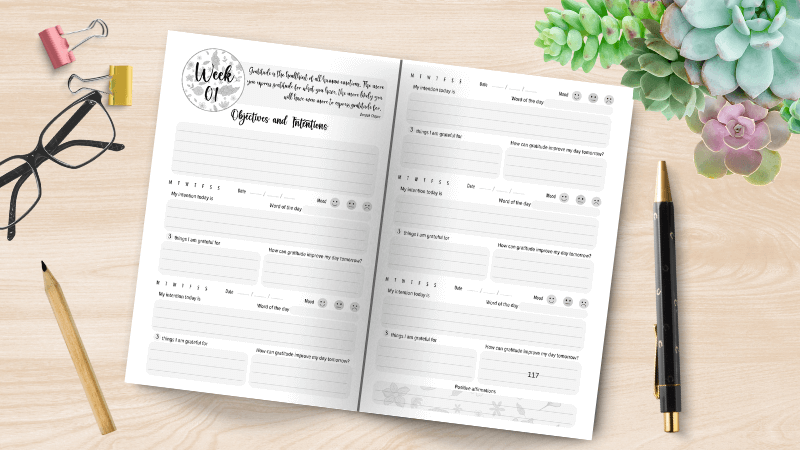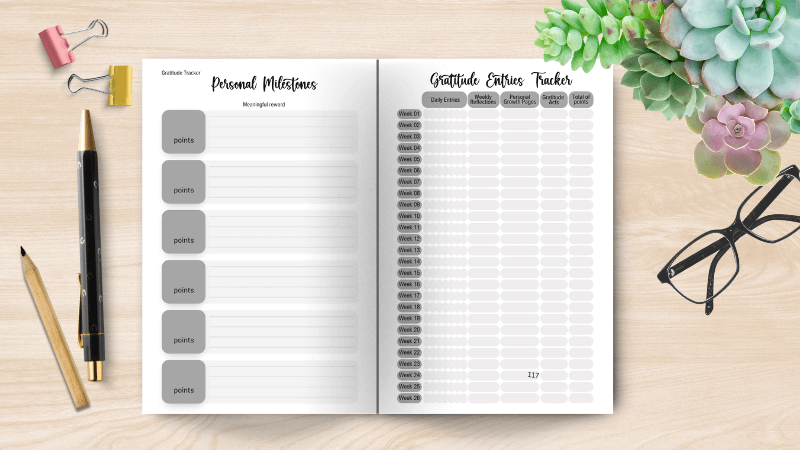Reading time: 25 minutes
Introduction
Imagine waking up every morning with a sense of calm and clarity, feeling grateful for the little things in life that often go unnoticed. This might sound like a dream, but it’s a reality you can achieve through the simple practice of keeping a gratitude journal. In a world where stress and negativity can easily overwhelm us, therefore, finding a way to focus on the positive can be a game-changer. A gratitude journal is a powerful tool that helps you shift your mindset and appreciate the good in your life, no matter how small.
You might be wondering, what exactly is a gratitude journal and how can it benefit me? In this article, we’ll dive into the ins and outs of gratitude journaling, exploring its many benefits and providing you with practical tips on how to get started and stick with it. From choosing the right journal to maintaining consistency, we’ve got you covered.
But first, let’s talk about why gratitude matters. Practicing gratitude isn’t just a feel-good exercise; it’s backed by science. Studies have shown that regularly acknowledging what you’re thankful for can improve your mental health, enhance your relationships, and even boost your immune system. As a result, it’s a simple yet effective way to transform your outlook on life.
We’ll guide you through every step of the journey, ensuring you have all the tools you need to succeed. Whether you’re new to journaling or looking to enhance your existing practice, this comprehensive guide will offer insights and inspiration to keep you motivated. So, grab your favorite notebook or digital app, and let’s embark on this transformative journey together.
Curious about how to start? Eager to experience the benefits for yourself? Keep reading to discover how a gratitude journal can change your life for the better.
Read more about the benefits of daily journaling for mental health and how you can incorporate morning journaling into your routine.
What is a Gratitude Journal?
A gratitude journal is more than just a diary; it’s a dedicated space where you regularly record things you’re thankful for. This simple yet profound practice encourages you to focus on the positive aspects of your life, no matter how small or insignificant they may seem. By doing so, you train your mind to see the good in everyday situations, fostering a more optimistic outlook on life.
Historical Significance of Gratitude
Historically, the concept of gratitude isn’t new. Many ancient cultures emphasized the importance of thankfulness in their traditions and rituals. For example, the ancient Romans celebrated a festival called “Lectisternium” where they expressed gratitude to their gods for their blessings. Similarly, various religious texts underscore the act of giving thanks, highlighting its timeless significance.
Modern-Day Relevance
In today’s fast-paced world, maintaining a gratitude journal has gained popularity due to its accessibility and the growing body of research supporting its benefits. Unlike traditional journaling, which might focus on a wide range of experiences and emotions, a gratitude journal zeroes in on the positive. This focused practice can be particularly powerful in helping you cultivate a sense of appreciation and contentment.
One of the beauties of a gratitude journal is its flexibility. You can choose to write in it daily, weekly, or whenever you feel the need to reflect on what you’re grateful for. There are no strict rules about what you should write. In fact, some people jot down simple bullet points, while others prefer to write detailed narratives. The key is to find a format that resonates with you and makes the practice enjoyable.
The Positive Impact of Gratitude Journaling
By dedicating just a few minutes each day to this practice, you can begin to experience a shift in your perspective. You’ll start to notice and appreciate the small joys that make life special, from a sunny day to a kind gesture from a stranger. Ultimately, this simple act of writing can lead to profound changes in your mindset and overall well-being.
So, what exactly can you include in a gratitude journal? Anything that brings you joy or makes you feel thankful. For instance, it could be something as mundane as a good cup of coffee or as significant as a promotion at work. The possibilities are endless, and that’s what makes this practice so versatile and effective.
Are you ready to start noticing and appreciating the positives in your life? Let’s delve deeper into the benefits of keeping a gratitude journal and discover how this simple tool can make a big difference.
Explore the benefits of daily journaling for mental health and learn how to incorporate morning journaling into your routine.
Benefits of Keeping a Gratitude Journal

When you start a gratitude journal, you’re not just engaging in a simple writing exercise; you’re opening the door to a myriad of benefits that can enhance your mental, physical, and social well-being. Let’s explore some of the profound advantages that come with this practice.
Mental Health Benefits
One of the most significant impacts of maintaining a gratitude journal is on your mental health. Regularly noting down things you’re grateful for can lead to reduced levels of stress and anxiety. When life gets overwhelming, it’s easy to focus on the negative. However, by shifting your focus to positive experiences, you can foster a sense of calm and clarity.
Reducing Stress and Anxiety
Writing about positive aspects of your day can serve as a powerful antidote to stress. It helps in managing anxiety by diverting your attention from worries to what’s going right in your life. This shift in focus can be incredibly therapeutic, offering a much-needed break from the daily grind of stressors.
Enhancing Emotional Resilience
Practicing gratitude regularly builds emotional resilience. It equips you with a positive mindset that can better handle life’s ups and downs. By acknowledging and appreciating the good, you develop a more balanced perspective, making it easier to cope with challenges.
Physical Health Benefits
The benefits of gratitude journaling extend beyond mental health, positively affecting your physical well-being as well. It might seem surprising, but the mind-body connection is strong, and your thoughts can significantly influence your physical health.
Improving Sleep Quality
Many people who keep a gratitude journal report better sleep. Reflecting on positive experiences before bed can lead to a more restful night, free from the worries and anxieties that often disturb sleep. A good night’s sleep, in turn, enhances your overall health and energy levels.
Boosting Immune System
A positive mindset, cultivated through regular gratitude journaling, can also strengthen your immune system. Studies have shown that people who practice gratitude tend to have better health outcomes, including lower blood pressure and fewer illnesses.
Social Benefits
Gratitude journaling doesn’t just improve your personal well-being; it also enhances your relationships and social interactions. Recognizing and appreciating the positive aspects of your interactions with others can lead to more fulfilling and meaningful relationships.
Strengthening Relationships
When you regularly acknowledge the kindness and support of others in your journal, you become more aware of these positive interactions. This heightened awareness can make you more appreciative and considerate in your relationships, fostering deeper connections and mutual respect.
Increasing Empathy and Social Connection
Gratitude journaling can also increase your empathy towards others. By reflecting on the good in your life, you become more attuned to the needs and feelings of those around you. This can lead to greater social connection and a sense of belonging, both of which are crucial for emotional health.
The benefits of keeping a gratitude journal are extensive and profound, touching every aspect of your life. From enhancing your mental and physical health to improving your relationships, this simple practice can lead to significant positive changes. So, are you ready to unlock these benefits and transform your life with a gratitude journal? Let’s move on to discover how you can start this journey.
How to Start Your Gratitude Journal

Starting a gratitude journal might seem like a daunting task, but with a few simple steps, you can easily incorporate this practice into your daily routine. Here’s a guide to help you get started and make the most out of your gratitude journaling experience.
Choosing the Right Journal
The first step in your gratitude journaling journey is selecting the right journal. This might seem trivial, but the journal you choose can significantly impact your commitment and enjoyment of the practice.
Physical Journal vs. Digital Apps
Decide whether you prefer a traditional physical journal or a digital app. Each has its advantages. A physical journal can be a tactile pleasure and allows for a more personal touch, such as doodles or decorative elements. On the other hand, digital apps can offer convenience and portability, making it easier to journal on the go.
Factors to Consider
When choosing a journal, consider factors such as size, design, and portability. If you plan to carry your journal with you, opt for a compact and durable one. Choose a design that resonates with you, as this can make the journaling process more enjoyable. Whether it’s a plain notebook, a leather-bound diary, or a themed gratitude journal, pick something that inspires you to write regularly.



Setting a Regular Time for Journaling
Consistency is key to reaping the benefits of gratitude journaling. Establishing a regular time for this practice helps to integrate it seamlessly into your routine.
Morning vs. Evening Routines
Decide whether you prefer to journal in the morning or the evening. Morning journaling can set a positive tone for the day, helping you start with a mindset of gratitude. Evening journaling, on the other hand, allows you to reflect on the day’s events and end your day on a positive note. Experiment with both to see which works best for you.
Finding What Works Best for You
There’s no right or wrong time to journal; it’s all about what fits into your lifestyle. Some people might find it beneficial to jot down their thoughts during lunch breaks or while commuting. The key is to find a time that you can stick to consistently, even if it means adjusting your schedule a bit.
Creating a Conducive Environment
The environment in which you journal can greatly influence your experience. Creating a space that promotes relaxation and focus can make the process more enjoyable and effective.
Quiet Space, Minimal Distractions
Choose a quiet space where you can write without interruptions. This could be a cozy corner in your home, a park, or even a café. Minimizing distractions will help you concentrate better and make the journaling process more meaningful.
Setting the Mood
Enhance your journaling experience by setting the mood. Soft lighting, calming music, or even a cup of your favorite tea can create a pleasant atmosphere. The goal is to make your journaling time something you look forward to, a peaceful retreat from your daily hustle and bustle.

By taking these steps to start your gratitude journal, you’re setting yourself up for a fulfilling and consistent practice. Choosing the right journal, finding the perfect time, and creating a conducive environment are all crucial elements in making gratitude journaling a rewarding habit. Ready to dive in? Let’s explore what you can write in your gratitude journal to keep the practice fresh and engaging.
What to Write in Your Gratitude Journal
Once you have your journal ready and a routine established, the next step is figuring out what to write. This is where the real magic happens, as the content you include in your gratitude journal can significantly impact its effectiveness. Here are some ideas to get you started and keep your entries varied and meaningful.
Daily Prompts and Ideas
A common challenge for many people is knowing what to write each day. Using prompts can help spark ideas and keep your journaling practice fresh.
Simple Lists
One of the easiest ways to start is by writing simple lists. Each day, jot down three to five things you’re grateful for. These can be small things, like enjoying a delicious meal, or bigger experiences, like spending time with loved ones. The key is to keep it varied and genuine.
Detailed Narratives
For those days when you have a bit more time, try writing detailed narratives about things you’re grateful for. Instead of just listing items, elaborate on why you’re grateful for them. Describe how they made you feel and why they are important to you. This deeper reflection can enhance your sense of gratitude and make the experience more enriching.
Different Formats and Structures
Varying the format and structure of your entries can keep the practice interesting and engaging.
Bullet Points vs. Paragraphs
Some days you might prefer the simplicity of bullet points, especially if you’re short on time. Other days, you might feel like writing in full paragraphs, providing more detail and context. Mixing up these formats can prevent your journaling practice from becoming monotonous.
Thematic Gratitude
Another approach is to focus on specific themes. For example, dedicate one week to being grateful for people in your life, another week to experiences, and another to personal qualities. This thematic focus can help you dig deeper into different areas of your life and uncover a broader range of things to be thankful for.
Pre-Made Gratitude Journals

For those who prefer a guided approach, pre-made gratitude journals can be an excellent option. These journals often come with structured prompts, inspirational quotes, and themed sections that make the journaling process straightforward and engaging.
Guided Prompts and Themes
Pre-made gratitude journals typically include guided prompts that can help you reflect on specific aspects of your life. These prompts can range from daily questions about what made you smile to weekly reflections on personal growth and achievements. Themed sections might focus on areas like relationships, work, or personal well-being, providing a comprehensive framework for your gratitude practice.
Incorporating Gamification
Many pre-made gratitude journals incorporate gamification elements to make the practice more interactive and enjoyable. Features like milestone tracking, stickers, and progress charts can motivate you to stay consistent. Celebrating small victories, such as completing a week of entries or reaching a personal goal, can enhance your sense of accomplishment and encourage continued engagement.
Pre-made gratitude journals are designed to take the guesswork out of the practice, offering a structured yet flexible approach to cultivating gratitude. They can be particularly beneficial for beginners or those who find it challenging to come up with daily entries. By providing a variety of prompts and themes, these journals ensure that your practice remains diverse and meaningful, helping you to maintain a positive mindset and appreciate the beauty in everyday moments.
Using Gratitude Quotes and Affirmations
Incorporating quotes and affirmations into your journal can provide additional inspiration and motivation.
Incorporating Inspirational Quotes
Start or end your entries with an inspirational quote about gratitude. Quotes from famous authors, spiritual leaders, or even friends and family can serve as a powerful reminder of the importance of gratitude. They can also provide a fresh perspective and new insights.
Writing Personal Affirmations
Affirmations are positive statements that can help you challenge and overcome negative thoughts. Create your own gratitude affirmations and include them in your journal. For example, write affirmations like “I am grateful for the abundance in my life” or “I appreciate the simple joys that bring me happiness.” Reading and writing these affirmations regularly can help reinforce a positive mindset.
By exploring these various ideas, prompts, and formats, you can keep your gratitude journaling practice dynamic and impactful. Whether you prefer simple lists or detailed narratives, thematic entries, or inspiring quotes, the key is to make the practice your own. Ready to make gratitude journaling a consistent habit? Let’s move on to tips for maintaining consistency and making it an integral part of your daily routine.


Tips to Maintain Consistency and Make It a Habit
Starting a gratitude journal is a wonderful first step, but maintaining consistency is crucial to fully reap its benefits. Here are some tips to help you stick with your gratitude journaling practice and make it a lasting habit.
Setting Reminders and Alarms
Creating a new habit often requires a little help, and setting reminders can be incredibly effective.
Using Technology to Your Advantage
Leverage your smartphone or digital devices to set daily reminders or alarms. Apps like Google Calendar or specialized journaling apps can prompt you at your chosen time each day. These reminders can be gentle nudges to ensure you don’t forget your journaling practice amidst your busy schedule.
Creating Visual Cues and Reminders
In addition to digital reminders, consider using visual cues around your home or workspace. Sticky notes on your mirror, desk, or even your fridge can serve as physical reminders to take a moment and jot down what you’re grateful for. These cues can keep the practice at the forefront of your mind.
Making It Enjoyable and Personal
Your gratitude journaling practice should be something you look forward to, not a chore. Personalizing and adding elements of enjoyment can significantly boost your commitment.
Customizing Your Journal
Add personal touches to your journal to make it more appealing. Use colorful pens, stickers, or washi tape to decorate the pages. Personalizing your journal can make the practice more enjoyable and something you look forward to each day.
Using Colors, Drawings, and Stickers
Incorporate creativity into your entries. Drawing small illustrations or using stickers can add a fun element to your journaling practice. These artistic touches not only make your journal visually appealing but also engage different parts of your brain, enhancing the overall experience.
Accountability and Support
Having someone to share your progress with can provide the motivation needed to stick with your journaling practice.
Sharing with a Friend or Community
Tell a friend or family member about your gratitude journaling practice. You can even encourage them to start their own. Sharing your experiences and discussing what you’re grateful for can deepen your practice and provide mutual support. Additionally, joining online communities or groups dedicated to gratitude journaling can offer inspiration and encouragement.
Joining Gratitude Groups or Challenges
Participate in gratitude challenges or groups where members share their entries and support each other. These groups often provide prompts and regular check-ins, helping you stay committed. Engaging with a community can make the practice feel more communal and less solitary, adding an element of accountability.
Maintaining consistency in your gratitude journaling practice requires a blend of reminders, personal touches, and social support. By integrating these tips into your routine, you can make gratitude journaling a lasting and enriching habit. Ready to tackle the obstacles that might come your way? Let’s explore how to overcome common challenges in the next section.
Overcoming Common Challenges
Even with the best intentions, it’s normal to encounter challenges that can hinder your gratitude journaling practice. Here are some common obstacles and practical solutions to help you stay on track.
Dealing with Writer’s Block
At times, you might find yourself staring at a blank page, unsure of what to write. This is a common hurdle but one that can be easily overcome with a few strategies.
Tips to Get Unstuck
When you’re struggling to find the right words, try using simple prompts to get started. Questions like “What made me smile today?” or “What is something small I appreciated today?” can kickstart your writing process. Sometimes, focusing on the sensory details—what you saw, heard, or felt—can also help generate ideas.
Seeking Inspiration from Different Sources
Look for inspiration outside your immediate environment. Read articles, watch videos, or listen to podcasts about gratitude. Sometimes, hearing about others’ experiences and insights can spark ideas and renew your enthusiasm for your journaling practice.
Staying Motivated
Maintaining motivation over the long term can be challenging, especially when life gets busy or stressful. However, there are strategies to keep your momentum going.
Revisiting Old Entries
One effective way to stay motivated is to revisit your past journal entries. Reading about what you were grateful for in the past can rekindle feelings of appreciation and remind you of the progress you’ve made. It can also provide a boost of positivity on days when you’re feeling down.
Celebrating Milestones
Set small, achievable goals for your journaling practice and celebrate when you reach them. For example, reward yourself after journaling consistently for a month. These celebrations can be simple, like enjoying a favorite treat or taking some time for a relaxing activity. Recognizing and rewarding your efforts can help sustain your motivation.

Managing Negative Emotions
There will be days when finding something to be grateful for feels impossible, especially during tough times. Learning how to navigate these moments is crucial for maintaining your practice.
Finding Gratitude During Tough Times
When faced with negative emotions or challenging situations, try to find small things that bring a glimmer of positivity. It could be as simple as a comforting cup of tea or a supportive friend. Acknowledging even the tiniest blessings can help shift your focus and gradually improve your mood.
Balancing Realism with Positivity
It’s important to be realistic and not force positivity. Gratitude journaling doesn’t mean ignoring difficulties. Instead, it’s about finding balance and recognizing that even in hard times, there are aspects of life that can be appreciated. Write about your struggles if you need to, and then try to find a silver lining, no matter how small.
Overcoming these common challenges can help you maintain a consistent and meaningful gratitude journaling practice. By addressing writer’s block, staying motivated, and managing negative emotions, you can ensure that your journal remains a source of positivity and growth. Ready to take your gratitude journaling to the next level? Let’s explore some advanced techniques in the next section.
Advanced Gratitude Journaling Techniques
Once you’ve established a regular gratitude journaling practice, you might be eager to explore advanced techniques to deepen your experience and maximize the benefits. Here are some strategies to enhance your gratitude journaling and keep it fresh and engaging.
Combining Gratitude with Other Practices
Integrating gratitude journaling with other personal growth practices can amplify its impact and create a more holistic approach to well-being.
Meditation and Mindfulness
Incorporating mindfulness and meditation into your gratitude practice can enhance your awareness and presence. Before you start journaling, spend a few minutes meditating to clear your mind and focus on the present moment. This can help you connect more deeply with your feelings of gratitude. Alternatively, you can journal after a mindfulness session to reflect on the positive aspects of your experience.
Visualization Exercises
Visualization is a powerful technique where you imagine positive outcomes or experiences in vivid detail. Try combining visualization with your gratitude journaling by envisioning future events or goals as if they have already happened. Write about these visions in your journal, expressing gratitude for them as if they are your current reality. This practice can help manifest your desires and reinforce a positive mindset.
Expanding Your Gratitude Practice
Taking your gratitude practice beyond the journal can further enrich your experience and spread positivity in your life and others’.
Gratitude Letters
Writing gratitude letters is a profound way to express your appreciation for the people who have made a difference in your life. Choose someone you feel grateful for, and write them a heartfelt letter detailing why you appreciate them and how they’ve impacted your life. Whether you send the letter or keep it for yourself, this practice can deepen your sense of connection and gratitude.
Gratitude Jars and Boards
A gratitude jar or board is a visual and interactive way to keep track of the things you’re thankful for. Each day, write down something you’re grateful for on a slip of paper and add it to your jar, or pin it to a gratitude board. Over time, watching the jar fill up or the board become more populated can be a powerful reminder of the abundance of good in your life.
Reflecting and Evolving Your Journal
Regular reflection on your journaling practice can help you understand its impact and identify areas for growth.
Regularly Reviewing and Reflecting
Set aside time periodically to review your past journal entries. Reflect on how your feelings of gratitude have evolved and what patterns you notice. This review can provide insights into your growth and remind you of the positive experiences you’ve recorded. It can also help you stay motivated and recognize the long-term benefits of your practice.
Setting New Goals and Intentions
As you progress in your gratitude journaling journey, consider setting new goals or intentions for your practice. Maybe you want to focus on a specific area of your life, like relationships or personal growth, or perhaps you want to challenge yourself to write more detailed entries. Setting new goals can keep your practice dynamic and aligned with your evolving needs and aspirations.
By incorporating these advanced techniques into your gratitude journaling practice, you can deepen your sense of appreciation and continue to grow emotionally and mentally. Whether you combine gratitude with other practices, expand your gratitude activities, or reflect and set new goals, these strategies will help you maintain a fulfilling and enriching journaling habit. Ready to wrap things up? Let’s move on to the conclusion and tie everything together.

Conclusion
Keeping a gratitude journal is a simple yet powerful practice that can transform your life in numerous ways. By regularly reflecting on the positive aspects of your life, you can enhance your mental and physical health, improve your relationships, and develop a more optimistic outlook.
We’ve explored the many benefits of gratitude journaling, from reducing stress and anxiety to boosting your immune system and strengthening your social connections. We’ve also provided practical tips on how to start your journal, what to write, and how to maintain consistency. Overcoming common challenges and incorporating advanced techniques can further enrich your practice, ensuring that you stay motivated and engaged.
So, what are you waiting for? Grab your favorite journal or download a journaling app, set aside a few minutes each day, and start noticing the good in your life. Remember, there’s no right or wrong way to do this – it’s all about what feels right for you and helps you cultivate a sense of gratitude.
If you’ve found this guide helpful, please leave a comment below sharing your thoughts or experiences with gratitude journaling. We’d love to hear from you! And while you’re at it, check out some of our other articles on self-care and personal growth, where you’ll find more tips and activities to enhance your well-being.
Thank you for taking the time to read this guide. Here’s to a more grateful and fulfilling life!






